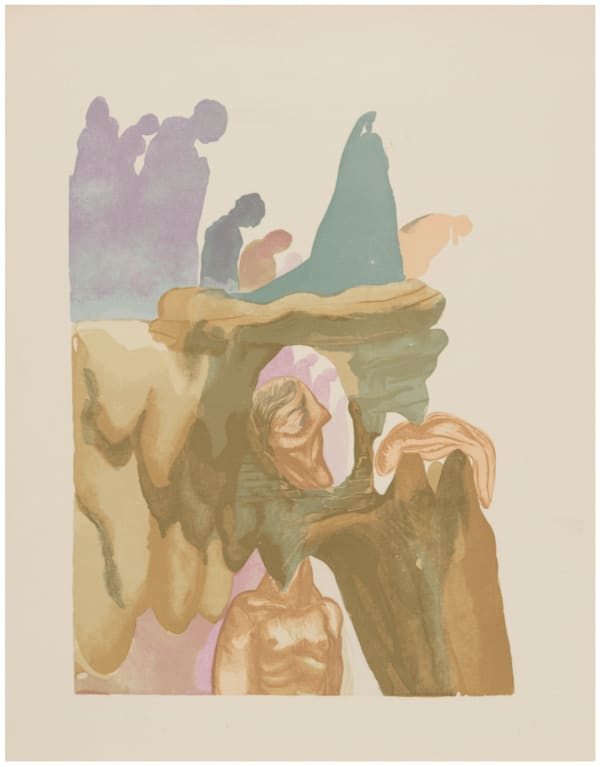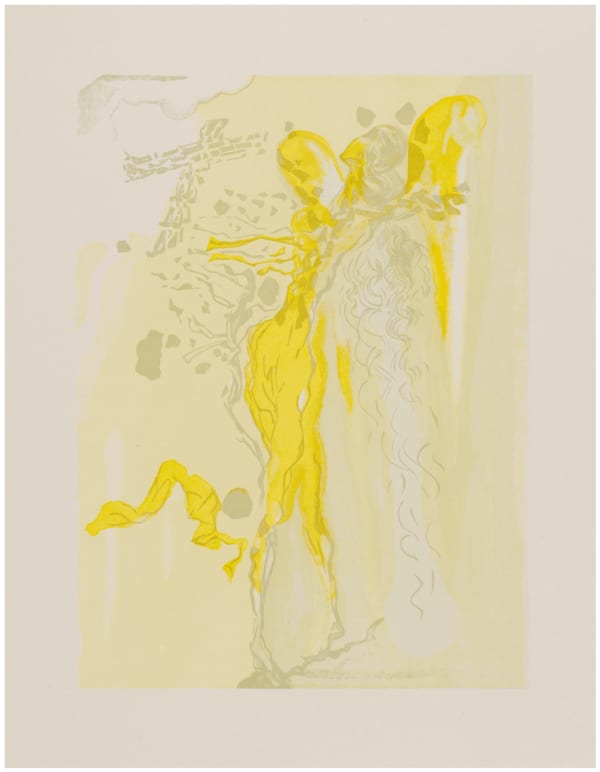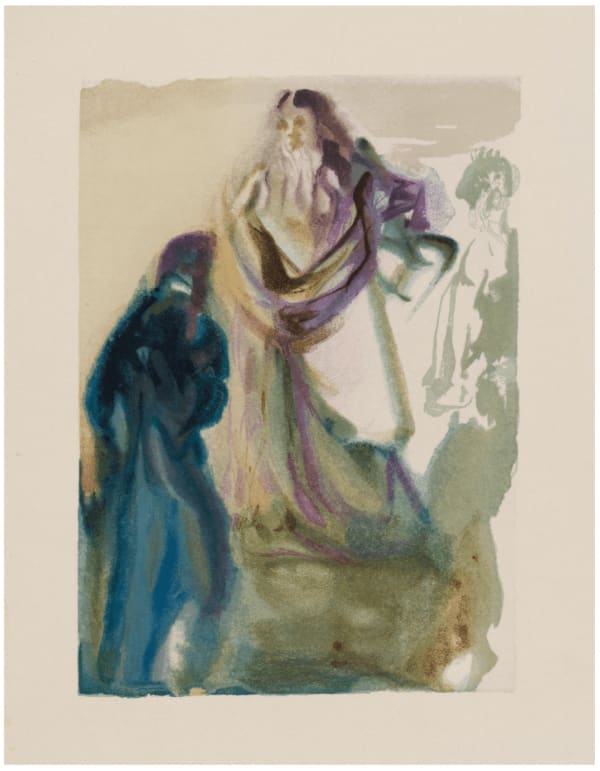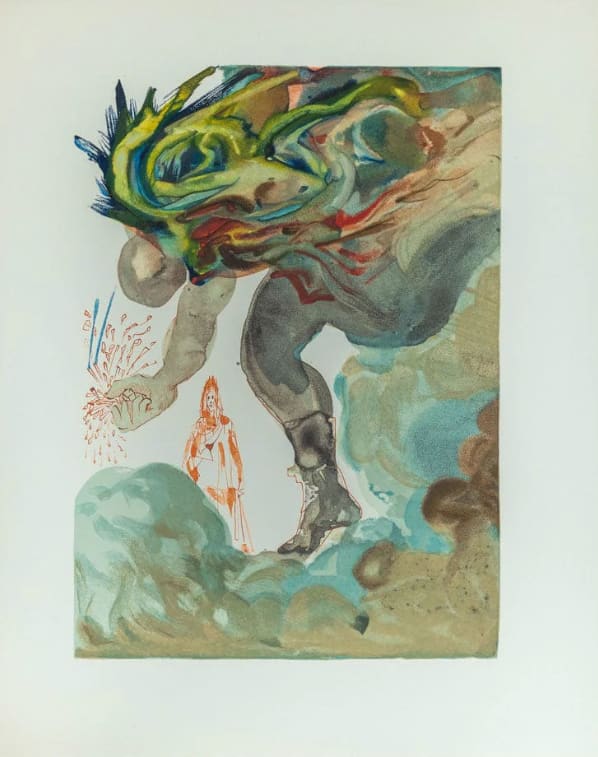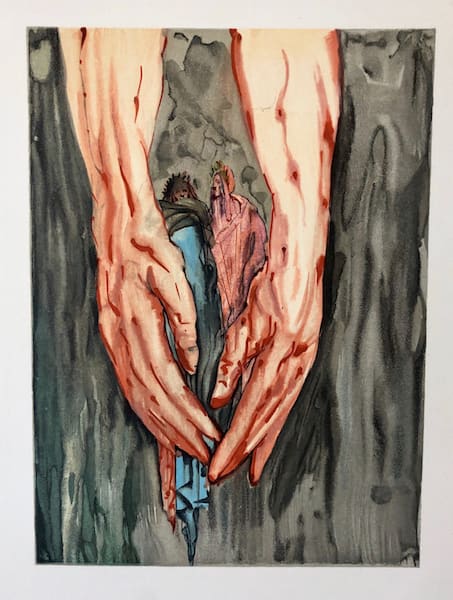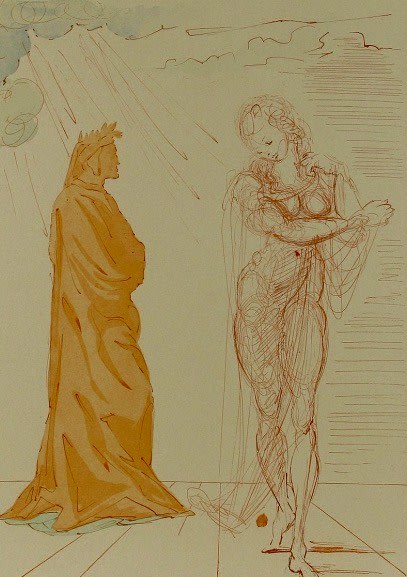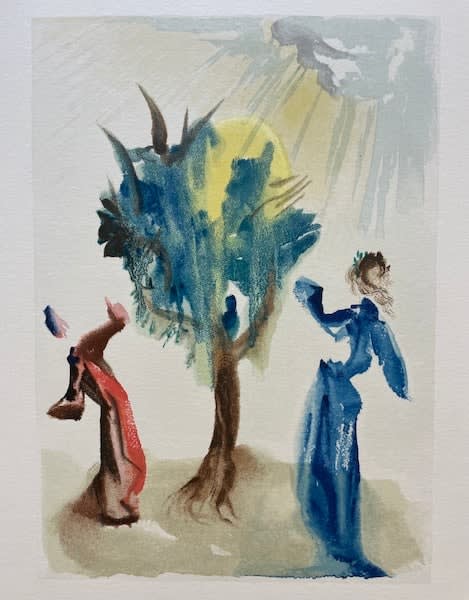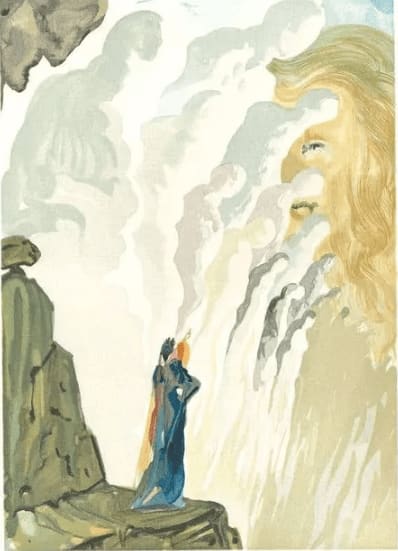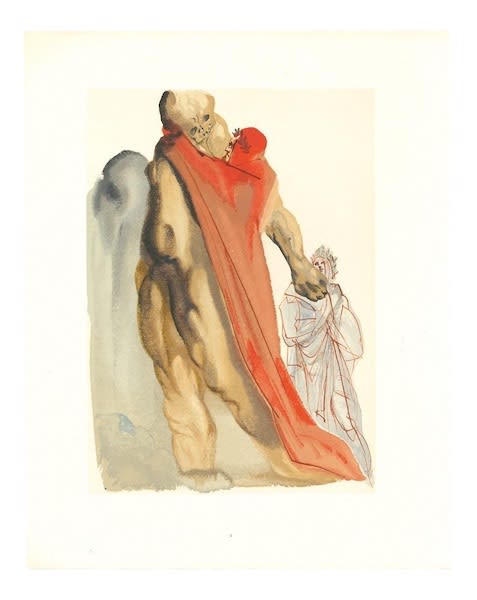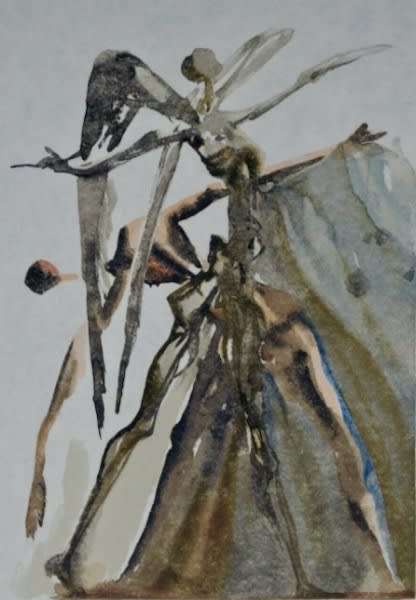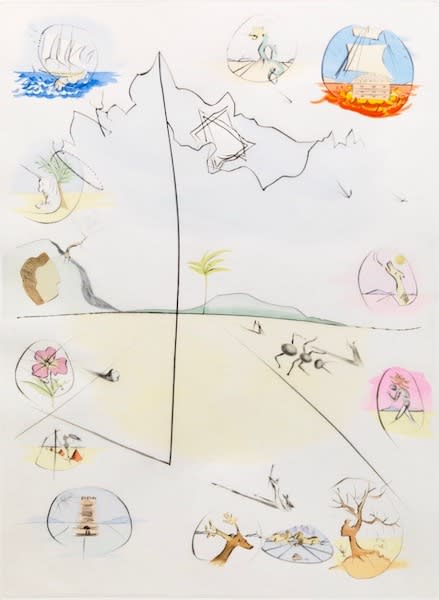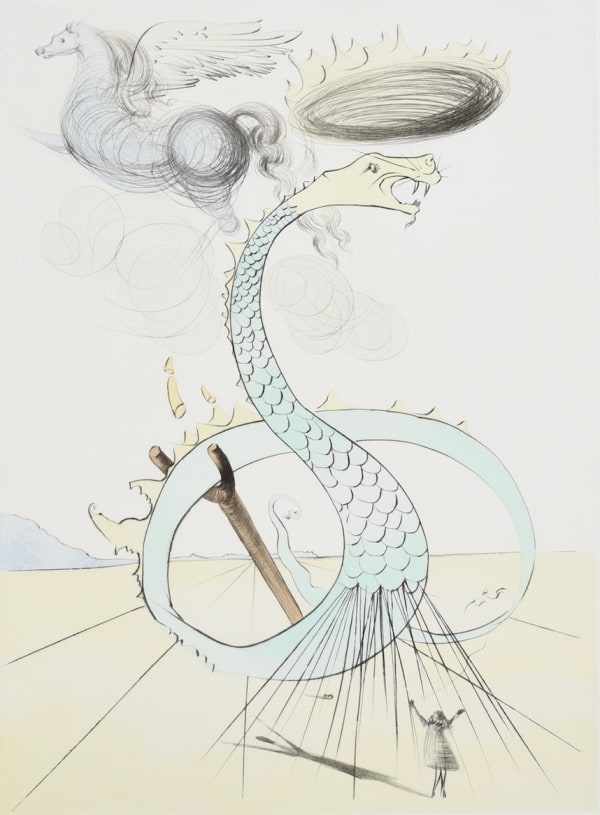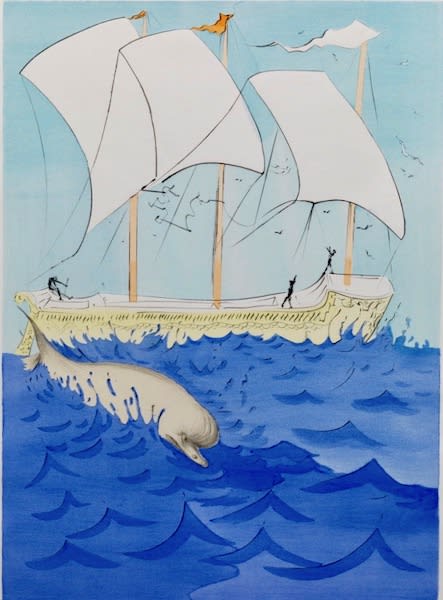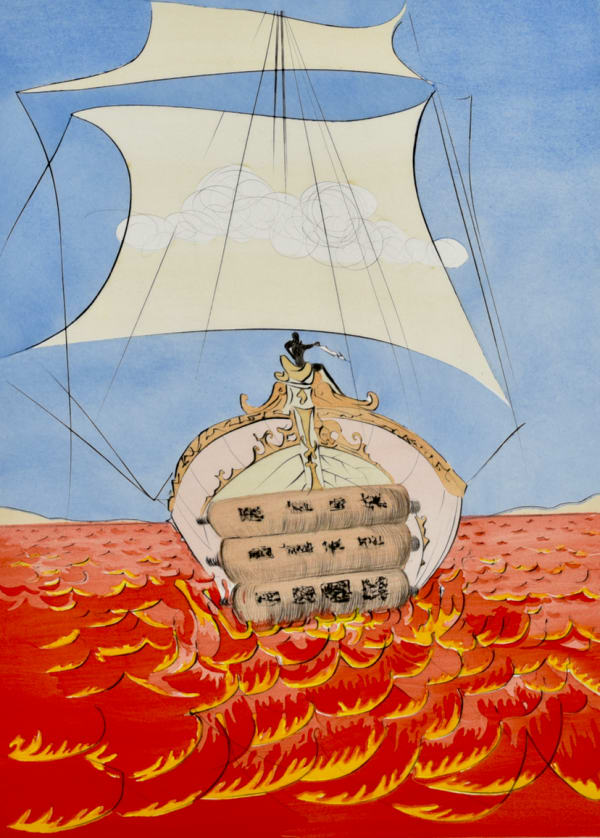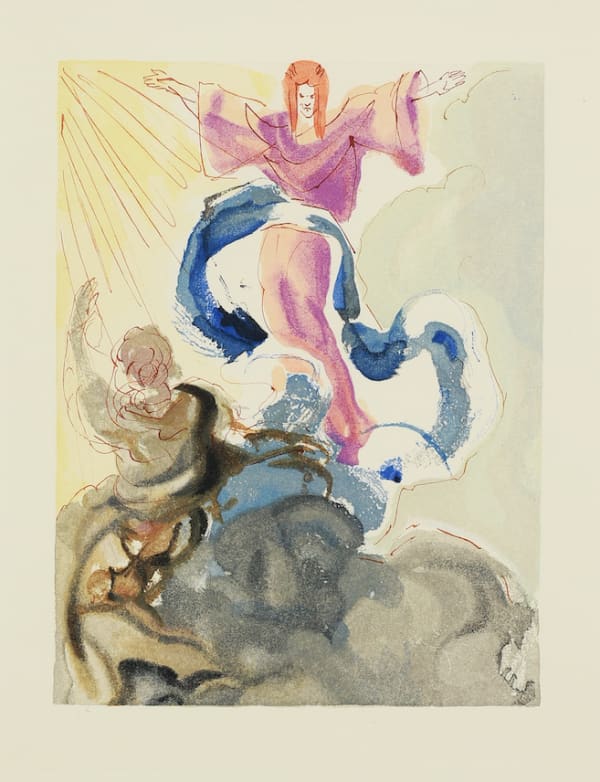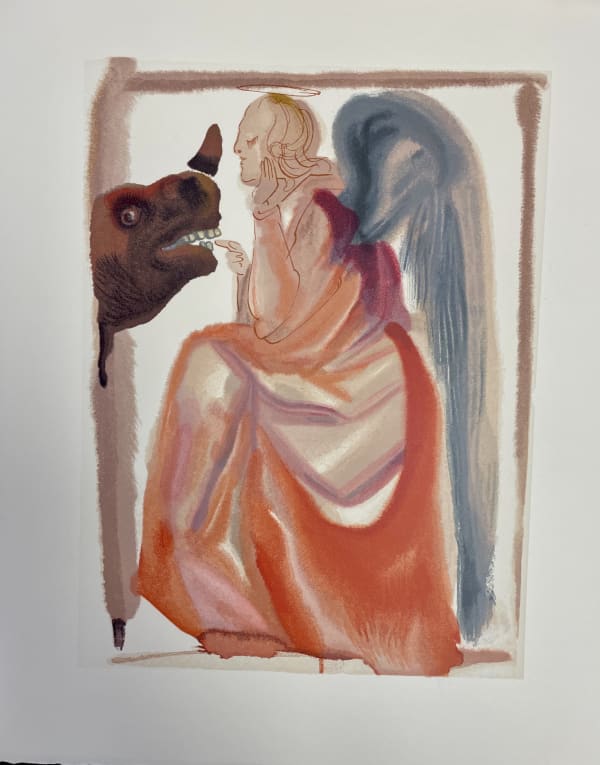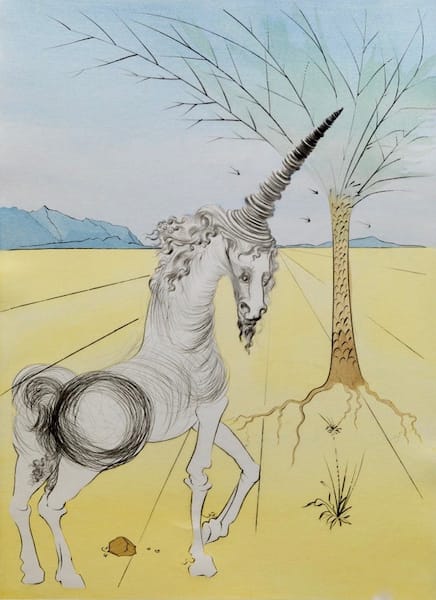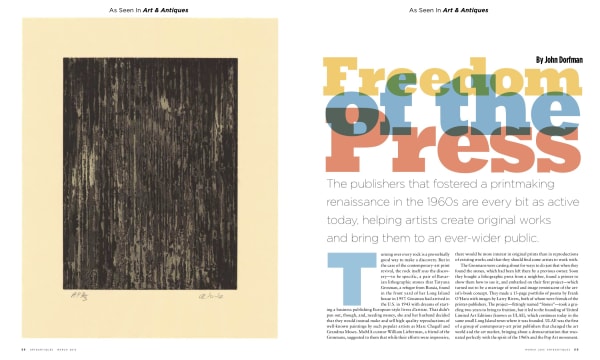Salvador Dali Spanish, 1904-1989
-
 Salvador DaliLe Singe et la Leopard, from Le Beastiaire de La Fontaine, 1974Engraving with stencil colors on Japon paper30.13 x 22.13"
Salvador DaliLe Singe et la Leopard, from Le Beastiaire de La Fontaine, 1974Engraving with stencil colors on Japon paper30.13 x 22.13" -
 Salvador DaliFraud, Proof, 1960Color woodcut10.13 x 7.13"
Salvador DaliFraud, Proof, 1960Color woodcut10.13 x 7.13" -
 Salvador DaliThe Corrupt, Proof, 1960Color woodcut10.13 x 7.13"
Salvador DaliThe Corrupt, Proof, 1960Color woodcut10.13 x 7.13" -
 Salvador DaliThe Cross of Mars, Proof, 1960Color woodcut10.13 x 7.13"
Salvador DaliThe Cross of Mars, Proof, 1960Color woodcut10.13 x 7.13" -
 Salvador DaliThe Dust of Souls, Proof, 1960Color woodcut10.13 x 7.13"
Salvador DaliThe Dust of Souls, Proof, 1960Color woodcut10.13 x 7.13" -
 Salvador DaliThe Apparition of Dante's Great-Great-Grandfather, Proof, 1960Color woodcut10.13 x 7.13"
Salvador DaliThe Apparition of Dante's Great-Great-Grandfather, Proof, 1960Color woodcut10.13 x 7.13" -
 Salvador DaliSt. Peter and Dante, Proof, 1960Color woodcut10.13 x 7.13"
Salvador DaliSt. Peter and Dante, Proof, 1960Color woodcut10.13 x 7.13" -
 Salvador DaliThe Traitor of Monteperti (Inferno), 1960Color woodcut13 x 10.5"
Salvador DaliThe Traitor of Monteperti (Inferno), 1960Color woodcut13 x 10.5" -
 Salvador DaliThe Prophecy of Vannu Fucci (Inferno), 1960Color woodcut13 x 10.5"
Salvador DaliThe Prophecy of Vannu Fucci (Inferno), 1960Color woodcut13 x 10.5" -
 Salvador DaliThe Joy of the Blessed, 1960Color woodcut13 x 10.5"
Salvador DaliThe Joy of the Blessed, 1960Color woodcut13 x 10.5" -
 Salvador DaliThe Garden of Christ, 1960Color woodcut13 x 10.5"
Salvador DaliThe Garden of Christ, 1960Color woodcut13 x 10.5" -
 Salvador DaliIn the Hands of Antaeus, 1960Color woodcut13 x 10.5"
Salvador DaliIn the Hands of Antaeus, 1960Color woodcut13 x 10.5" -
 Salvador DaliThe Delightful Mount, 1960Color woodcut13 x 10.5"
Salvador DaliThe Delightful Mount, 1960Color woodcut13 x 10.5" -
 Salvador DaliVirgil Consoles Dante, 1960Color woodcut13 x 10.5"
Salvador DaliVirgil Consoles Dante, 1960Color woodcut13 x 10.5" -
 Salvador DaliVirgil's Last Words (Pergatory), 1960Color woodcut13 x 10.5"
Salvador DaliVirgil's Last Words (Pergatory), 1960Color woodcut13 x 10.5" -
 Salvador DaliThe Golden Age (Pergatory), 1960Color woodcut13 x 10.5"
Salvador DaliThe Golden Age (Pergatory), 1960Color woodcut13 x 10.5" -
 Salvador DaliThe Tree of Punishment (Pergatory), 1960Color woodcut13 x 10.5"
Salvador DaliThe Tree of Punishment (Pergatory), 1960Color woodcut13 x 10.5" -
 Salvador DaliThe Avaricious (Pergatory), 1960Color woodcut13 x 10.5"
Salvador DaliThe Avaricious (Pergatory), 1960Color woodcut13 x 10.5" -
 Salvador DaliOur Lady of Annunciation (Purgatory), 1960Color woodcut13 x 10.5"
Salvador DaliOur Lady of Annunciation (Purgatory), 1960Color woodcut13 x 10.5" -
 Salvador DaliEcstatic Visions, 1960Color woodcut13 x 10.5"
Salvador DaliEcstatic Visions, 1960Color woodcut13 x 10.5" -
 Salvador DaliVirgil's Admonishment (Purgatory), 1960Color woodcut13 x 10.5"
Salvador DaliVirgil's Admonishment (Purgatory), 1960Color woodcut13 x 10.5" -
 Salvador DaliThe Powers of Soul (Purgatory), 1960Color woodcut13 x 10.5"
Salvador DaliThe Powers of Soul (Purgatory), 1960Color woodcut13 x 10.5" -
 Salvador DaliThe Archangel Gabriel (Paradise), 1960Color woodcut13 x 10.5"
Salvador DaliThe Archangel Gabriel (Paradise), 1960Color woodcut13 x 10.5" -
 Salvador DaliThe Proud One (Paradise), 1960Color woodcut13 x 10.5"
Salvador DaliThe Proud One (Paradise), 1960Color woodcut13 x 10.5" -
 Salvador DaliThe Golden Helmet of Mandrino, from Historia de Don Quichotte de la Mancha, 1980Etching and aquatint in colors30 x 22"Sold
Salvador DaliThe Golden Helmet of Mandrino, from Historia de Don Quichotte de la Mancha, 1980Etching and aquatint in colors30 x 22"Sold -
 Salvador DaliLe musee de genie et du caprice, from After 50 Years of Surrealism, 1974Etching with hand coloring26 x 19.75"Sold
Salvador DaliLe musee de genie et du caprice, from After 50 Years of Surrealism, 1974Etching with hand coloring26 x 19.75"Sold -
 Salvador DaliJoseph (Twelve Tribes of Israel), 1973Color etching25.5 x 19.75"
Salvador DaliJoseph (Twelve Tribes of Israel), 1973Color etching25.5 x 19.75" -
 Salvador DaliGad (Twelve Tribes of Israel), 1973Color etching25.5 x 19.75"
Salvador DaliGad (Twelve Tribes of Israel), 1973Color etching25.5 x 19.75" -
 Salvador DaliSimon (Twelve Tribes of Israel), 1973Color etching25.5 x 19.75"
Salvador DaliSimon (Twelve Tribes of Israel), 1973Color etching25.5 x 19.75" -
 Salvador DaliFrontispiece (Twelve Tribes of Israel), 1973Color etching25.5 x 19.75"Sold
Salvador DaliFrontispiece (Twelve Tribes of Israel), 1973Color etching25.5 x 19.75"Sold -
 Salvador DaliReuben (Twelve Tribes of Israel), 1973Color etching25.5 x 19.75"
Salvador DaliReuben (Twelve Tribes of Israel), 1973Color etching25.5 x 19.75" -
 Salvador DaliIssachar (Twelve Tribes of Israel), 1973Color etching25.5 x 19.75"Sold
Salvador DaliIssachar (Twelve Tribes of Israel), 1973Color etching25.5 x 19.75"Sold -
 Salvador DaliDan (Twelve Tribes of Israel), 1973Color etching25.5 x 19.75"
Salvador DaliDan (Twelve Tribes of Israel), 1973Color etching25.5 x 19.75" -
 Salvador DaliAsher (Twelve Tribes of Israel), 1973Color etching25.5 x 19.75"
Salvador DaliAsher (Twelve Tribes of Israel), 1973Color etching25.5 x 19.75" -
 Salvador DaliBenjamin (Twelve Tribes of Israel), 1973Color etching25.5 x 19.75"
Salvador DaliBenjamin (Twelve Tribes of Israel), 1973Color etching25.5 x 19.75" -
 Salvador DaliZebulon (Twelve Tribes of Israel), 1973Color etching25.5 x 19.75"
Salvador DaliZebulon (Twelve Tribes of Israel), 1973Color etching25.5 x 19.75" -
 Salvador DaliNapthali (Twelve Tribes of Israel), 1973Color etching25.5 x 19.75"
Salvador DaliNapthali (Twelve Tribes of Israel), 1973Color etching25.5 x 19.75" -
 Salvador DaliJudah (Twelve Tribes of Israel), 1973Color etching25.5 x 19.75"
Salvador DaliJudah (Twelve Tribes of Israel), 1973Color etching25.5 x 19.75" -
 Salvador DaliLevi (Twelve Tribes of Israel), 1973Color etching25.5 x 19.75"
Salvador DaliLevi (Twelve Tribes of Israel), 1973Color etching25.5 x 19.75" -
 Salvador DaliPiccarda Donati (Paradise), 1960Color Woodcut13 x 10.5"Sold
Salvador DaliPiccarda Donati (Paradise), 1960Color Woodcut13 x 10.5"Sold -
 Salvador DaliThe Hard Margins, 1960-63Woodblock print13 x 10.5"Sold
Salvador DaliThe Hard Margins, 1960-63Woodblock print13 x 10.5"Sold -
 Salvador DaliDante Purified (Purgatory), 1960Color Woodcut13 x 10.5"
Salvador DaliDante Purified (Purgatory), 1960Color Woodcut13 x 10.5" -
 Salvador DaliFarinata (Inferno), 1960Color Woodcut13 x 10.5"Sold
Salvador DaliFarinata (Inferno), 1960Color Woodcut13 x 10.5"Sold -
 Salvador DaliChurch and Empire (Paradise), 1960Color Woodcut13 x 10.5"Sold
Salvador DaliChurch and Empire (Paradise), 1960Color Woodcut13 x 10.5"Sold
Salvador Dalí was a leading proponent of Surrealism, the 20-century avant-garde movement that sought to release the creative potential of the unconscious through strange, dream-like imagery. “Surrealism is destructive, but it destroys only what it considers to be shackles limiting our vision,” he said. Dalí is specially credited with the innovation of “paranoia-criticism,” a philosophy of art making he defined as “irrational understanding based on the interpretive-critical association of delirious phenomena.” In addition to meticulously painting fantastic compositions, such as The Accommodations of Desire (1929) and the melting clocks in his famed The Persistence of Memory (1931), Dalí was a prolific writer and early filmmaker, and cultivated an eccentric public persona with his flamboyant mustache, pet ocelot, and outlandish behavior and quips. “Each morning when I awake, I experience again a supreme pleasure,” he once said. “That of being Salvador Dalí.”
Salvador Dalí was a leading proponent of Surrealism, the 20-century avant-garde movement that sought to release the creative potential of the unconscious through strange, dream-like imagery. “Surrealism is destructive, but it destroys only what it considers to be shackles limiting our vision,” he said. Dalí is specially credited with the innovation of “paranoia-criticism,” a philosophy of art making he defined as “irrational understanding based on the interpretive-critical association of delirious phenomena.” In addition to meticulously painting fantastic compositions, such as The Accommodations of Desire (1929) and the melting clocks in his famed The Persistence of Memory (1931), Dalí was a prolific writer and early filmmaker, and cultivated an eccentric public persona with his flamboyant mustache, pet ocelot, and outlandish behavior and quips. “Each morning when I awake, I experience again a supreme pleasure,” he once said. “That of being Salvador Dalí.”
-

Winter's Muse: A Holiday Group Exhibition
Group Exhibition for the Holiday Season 13 Dec 2024 - 3 Jan 2025 Laguna Beach, Palm DesertCelebrate the season with Winter’s Muse: A Group Holiday Exhibition , a showcase of works by celebrated artists whose muses embody the beauty, grace, and inspiration of winter. This Holiday...Read more -

Blooms and Brushstrokes
A Group Exhibition 11 Jul - 22 Sep 2024 Laguna Beach'Blooms and Brushstrokes' on view from July 11, 2024 through September 22, 2024. 326 Glenneyre Street Laguna Beach, CA (949) 497-4988 RSVP: info@dawsoncolefineart.comRead more -

Salvador Dalí
The Twelve Tribes of Israel 20 Oct 2023 - 31 May 2024Dawson Cole Fine Art is pleased to present “Salvador Dalí: The Tribes of Israel” at the Ritz-Carlton, Laguna Niguel. Best known for his unique and imaginative artwork characterized by dreamlike...Read more -

Splash of Summer
A Group Exhibition 31 Jul - 8 Sep 2023 Laguna Beach, Palm DesertStep into a vibrant world of art that captures the essence of the season at the mesmerizing exhibition, 'Splash of Summer.' This exhilarating showcase is a celebration of all things...Read more -

Salvador Dalí: The Twelve Tribes of Israel
22 Nov - 31 Dec 2021 Laguna Beach, Palm DesertDawson Cole Fine Art is pleased to present an online exhibition of rare etchings by distinguished Spanish artist Salvador Dali (1904-89). Salvador Dalí was an icon of Surrealism, the 20th-century...Read more -

Dinner with Dali
20 Oct 2015 Laguna BeachSalvador Dalí and the St. Regis Hotel have had a long history together. Throughout the 1960s and ’70s, the famed surrealist painter, his wife, and their pet ocelot (of course)...Read more
-

The Ritz Carlton, Laguna Nigel + Salvador Dali
Salvador Dali's "The Tribes of Israel" On Display at the Ritz-Carlton, Laguna Niguel July 28, 2023 Read more -

As Seen in "Art & Antiques": Freedom of the Press
July 27, 2020 Read more -

California Homes Magazine August 2019
Shopping for Art in Laguna Beach August 1, 2019Celebrating its 22nd year, Dawson Cole Fine Art was recently featured in California Homes Magazine's August 2019 issue as one of the 'go to' places...Read more


